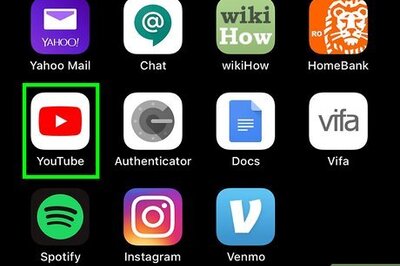
views
Washington: As he opened an event that had brought 200 conservative social media firebrands to the White House, President Donald Trump wanted his guests to know just how much he appreciated their work helping shape the online narrative about his presidency and a reelection fight.
“The crap you think of,” Trump said as he surveyed his Twitter kingdom, “is unbelievable.”
Trump was once an outsider political candidate who prided himself on bending rules and subverting norms, and he wants to keep that sensibility as a candidate in 2020. So Thursday, the president went in search of outside-the-box campaign ideas from a group that also has little use for playing by the rules.
Sandwiched between a flurry of morning presidential tweets and bleeding into Trump’s early evening news conference on how his administration would collect data on citizenship, the White House Social Media Summit was dominated by activists willing to share unverified smears against Democratic presidential candidates, disseminate QAnon conspiracy theories and create memes the president might share.
“Earlier this year, the White House launched a tool to allow Americans, regardless of their political views, to share how they have been affected by bias online,” Judd Deere, a White House spokesman, said in an email explaining the origins of the event. “After receiving thousands of responses, the president wants to engage directly with these digital leaders in a discussion on the power of social media.”
That’s really not what happened.
Before all was said and done, the East Room event featuring a rambling speech by Trump on everything from Federal Reserve policy to his hairstyle devolved into a confrontation in the Rose Garden after the presidential news conference between Sebastian Gorka, the former White House official-turned-media-personality, and a reporter as James O’Keefe, an activist who likes to capture videos under false pretenses to embarrass liberals and journalists, filmed the scene.
The reporter, Brian Karem of Playboy, said that the group was hungry for “demonic possession.” Gorka questioned his journalistic credentials and approached Karem, who suggested the two talk outside.
“Gorka! Gorka! Gorka!” his supporters chanted as Gorka called the journalist a “punk.”
Another activist, Joy Villa, preened in the background in a floor-length red gown emblazoned with the word “freedom.” “Fake news is over!” Villa shouted amid the melee, before talking about who designed her gown.
Other supporters who had made the journey from the internet’s backwaters to the White House included “Carpe Donktum,” who created a fake video of Joe Biden, the former vice president, that Trump shared on Twitter. There was also Bill Mitchell, who enjoys discussing QAnon, an online conspiracy theory that purports to share government secrets. And there was Ali Alexander, who shared a tweet questioning Sen. Kamala Harris’ racial background.
Ostensibly, the entire exercise was a chance for Trump to hear grievances from his supporters. That is what some of them said, anyway. Charlie Kirk, the 25-year-old founder of Turning Point USA, a group that reaches out to young conservatives, said before the event that he was going into it with a “center right” view on how the president should search for evidence that social media platforms were silencing conservative voices. Kirk and members of his organization have been criticized by the Southern Poverty Law Center for tweets that contained anti-immigrant or racist views.
“I think that’s a positive thing that the president is hearing new ideas and entertaining difference of opinion” and seeing if he could use his power to tackle conservatives’ complaints, Kirk said.
The president and his supporters feel as though their voices have been silenced by platforms like Twitter, Facebook and Google, while making the somewhat confounding argument that their efforts are indeed covered breathlessly in the media but just not to their liking.
Weeks ago, the president and his social media director, Dan Scavino, hatched the idea to hold the event. The White House created a website that was meant to capture evidence of Google, Twitter and Facebook suppressing conservative voices. In the end, representatives of all three were left off the guest list.
“At a time when social media platforms are banning conservative voices and supporters of the president,” said Brad Parscale, the president’s 2020 campaign manager, “it’s important for President Trump to emphasize that he appreciates their support and wants to protect their First Amendment rights.”
Before the event devolved into a dumpster fire in the Rose Garden, Trump treated his audience to an unusually detailed look into one of the hallmarks of his presidency — his tweets. He said his tweets were intended to kick-start a new news cycle, and lately he was wondering why he seemed to notice lower engagement numbers. Could something more nefarious be afoot?
“I used to watch it like a rocket ship when I put out a beauty,” Trump said, waxing poetic about those early days running the Twitter account as president. Recounting a tweet accusing President Barack Obama of wiretapping his office, he said: “Remember I said somebody was spying on me? That was like a rocket.”
Trump had special praise for his golf-caddie-turned-social-media impresario. Once upon a time, Trump noticed that Scavino — “My Dan,” as he called him — loved to stare at his computer screen all day long. These days, he said, Scavino works directly with many of the president’s digital supporters, who send him content that he then runs by the president in the Oval Office. That summary was pretty much open confirmation of the White House’s slapdash social media system.
“He works about 28 hours a day,” Trump said, “working with all of you, many of you.”
In between complaining about houseflies — “I don’t like flies!” — and talking about his hair, Trump gave his own unique interpretation of the First Amendment.
“To me free speech is not when you see something good and then you purposely write bad,” Trump said, describing the kind of thing the First Amendment is designed to protect. “To me that’s very dangerous speech, and you become angry at it. But that’s not free speech.”
Not surprisingly, the whole concept of the event alarmed the president’s critics.
Madihha Ahussain, a lawyer with Muslim Advocates, a nonprofit legal and advocacy organization, described it as a ruse.
“Enforcing basic standards of decency on social media isn’t censoring conservative speech,” Ahussain said in a statement. “Hate speech is hate speech, regardless of whether the person spewing it has met with the president.”
She added, “We urge social media platforms to ignore the circus at the White House and instead commit to enforcing their hate-content policies objectively and forcefully.”
Thomas Melia, the Washington director of the PEN American Center, a nonprofit organization that advocates press freedom and advancement of literature, said that the United States needed “high-level dialogues” about the role of private companies in the practice of content moderation and crafting terms of service policies.
The White House, Melia said, was not the place for this Thursday.
“Sadly,” he said, “today’s gathering entirely misses the mark with its highly politicized guest list that excludes important voices and includes conspiracy peddlers and purveyors of false information who might more rightly be viewed as part of the problem.”
Katie Rogers © 2019 The New York Times


















Comments
0 comment